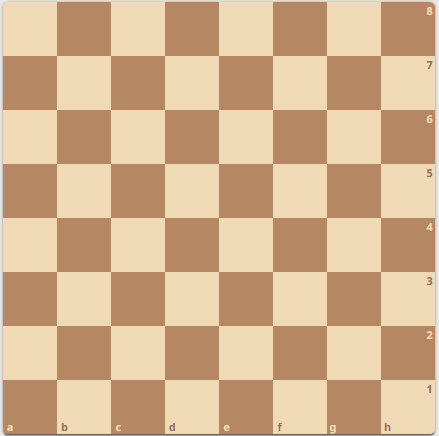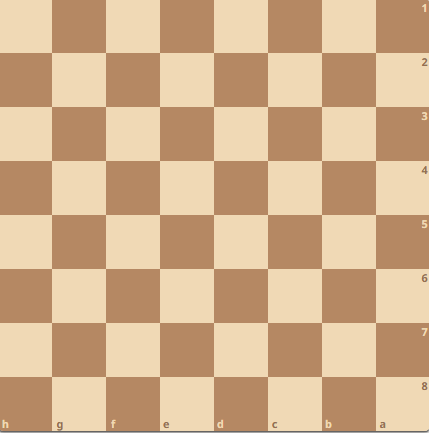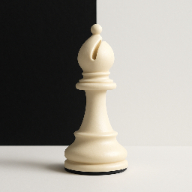Introduction
You’ve probably heard a streamer or a YouTuber going something like “Knight f6” or “h5” or “King f1”.
That’s chess notation, a way of recording and reading moves in chess. It enables players to discuss chess with others and to calculate and remember moves more intentionally. The blog posts on this site contain a lot of it.
Now, a chess board is labeled using letters of the alphabet (a to h) and numbers (1-8).
The vertical lines are referred to as files, and are labeled using the letters. The horizontal lines are called ranks and are represented by the numbers.
So for the vertical lines we have the a, b, c, d, e, f, g, and h files. For the horizontal lines we have the 1st, 2nd, 3rd, 4th, 5th, 6th, 7th and 8th ranks.
Here is a visual representation of that:

From white’s view

From black’s view
How to write moves
1. Pawn moves

A pawn move is recorded by writing the name of the square it moved to. e.g. If a pawn is moved to e4, the move is recorded as e4.
However, when a pawn captures, we write the file it came from, followed by an “x”, and the square it moved to when it captured. e.g. If a pawn on the h3 captures a bishop on g4, we write the move as hxg4.
Check out En passant .
2. Knight moves

A knight move is recorded by writing first an “N”, then the square it goes to. e.g. A knight moving to e5 without capturing anything is written as Ne5.
If it captured something on e5, like a pawn or any other piece, we would write the move as Nxe5.
3. Bishop moves

A bishop move is recorded by writing first an “B”, then the square it goes to. e.g. A bishop moving to b5 without capturing anything is written as Bb5.
If it captures something on the square it goes to, we write an “x” between the “B” and the square to show that its not just a move, its a capture. e.g. A bishop capturing a rook, say maybe on a1, can be recorded as Bxa1.
4. Rook moves

A rook move is recorded by writing first an “R”, then the square it goes to. e.g. A rook moving from d1 to d4 without capturing anything is written as Rd4.
If it captures something on the square it goes to, we write an “x” between the “R” and the square on which it captures that piece e.g. If the rook captures a queen on d4, we write the move as Rxd4.
5. Queen moves

A queen move is recorded by writing first a “Q”, then the square it goes to. e.g. A queen moving to f3 without capturing anything is written as Qf3.
If it captures something on the square it goes to, we write an “x” between the “Q” and the square to show that its a capture. e.g. A queen capturing a bishop, say maybe on b7, can be recorded as Qxb7.
6. King moves

A king move is recorded by writing first a “K”, then the square it goes to. e.g. A king moving to f1 without capturing anything is written as Kf1.
If it captures something on the square it goes to, we write an “x” between the “K” and the square to show that its a capture. e.g. A king capturing a pawn, say maybe on c4, can be recorded as Kxc4.
When the king short-castles, the move is recorded as O-O. When it long castles, it is recorded as O-O-O.
CHECKS and CHECKMATE
Moves that are checks on the king are written with a “+” at the end. For example, Qh5+.
If the move is a checkmate, it is written with a “#” at the end. For example, if the Qh5+ move is actually checkmate, it is written as Qh5#.
Two pieces of the same kind can go to the same square
In some instances, you’ll find that its not just one rook, or not just one knight, or not just one bishop that can go to a square.
In that case, you specify which piece moves to that square by including its file in the notation. For example, if you want to move your rook on f1 to e1, normally we just write that as Rf1. However, if there is a another rook on the 1st rank that can go to f1, you have to write the move as Rfe1. The “f” in the notation shows that we moved the f1 rook to e1, not the other one.
The same applies for knights and bishops.
Now if the pieces are on the same file, you specify which you are moving but including the rank of that piece in the notation. e.g. N3xd4, to show a capture on d4 with a knight from f3, supposing your other knight is on f5 and can therefore also take on d4.

 and then
and then